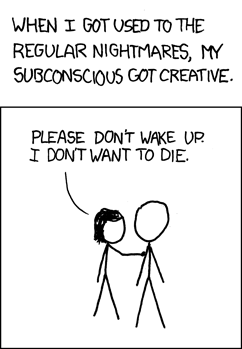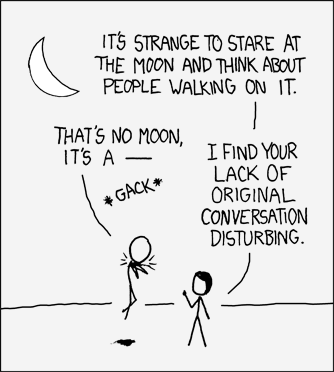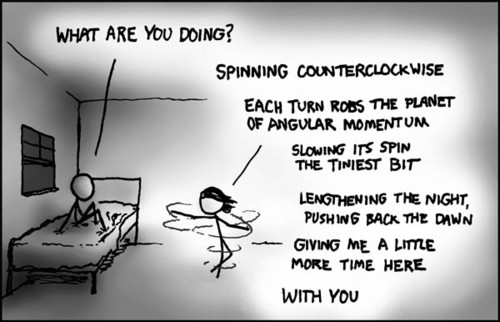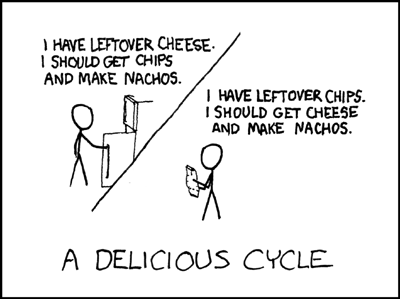
In this strip, a female is at a computer purchasing techno music on Apple’s iTunes Music Store. The male glances over her shoulder and questions her purchase. The female is clearly exasperated by the male’s question, as witnessed by her short response and body language of a slouched posture while looking away from him with her head resting in her palm. She seems to know what’s coming.
The male then proceeds to ask the female if she couldn’t just make a copy of the 15-second free sample and loop it, since that would basically be the same thing as purchasing the entire song. Obviously, the male doesn’t listen to, let alone enjoy, techno music. This is a common criticism from people regarding music they consider to be inferior to what they listen to - everything sounds the same. To a person unfamiliar with the nuance of the music, this could be especially easy to say about techno since it is often repetitive and droning by design. This entire scenario would never have happened if she was purchasing music he considered to be “real,” such as They Might Be Giants or Jonathan Coulton.
Please note that, once again, the female is the dominant figure, simply enduring the annoying tendencies of the males the author chooses to portray.
February 28, 2008 at 12:00am
1 note

The Author admits that at this point in his life, female companionship is hard to come by. This is a common phase in life for many geek males, one that typically lasts from ages 13-65. At this phase of his life the Author–being a sensitive geek who believes that females deserve unconditional adulation–is terrified of offending even imaginary women.
December 24, 2007 at 12:00am
4 notes

In this Christmas-edition XKCD, the Author adapts the classic Clement Clarke Moore Poem, “A Visit from St. Nicholas” to reflect upon the common sleep patterns of college students. Many a student coming home from college and used to an extremely late (or perhaps more accurately: early) sleep schedule. This sleep schedule is much lauded by people who learned everything they know about the the so-called “hacker culture” from Eric Raymond essays and the movie “Hackers”.
The strip culminates in a terse exchange between Santa Clause, who is admonishing the man for being up so late. A snappy comeback which firmly states the disconnect between a child’s sleep schedule and an adults serves as a punchline to this unusual long-frame format strip.
Your Curator understands that this strip in particular may be difficult to grasp, as it lacks a traditional comic structure. It is important to remember that for a certain segment of the XKCD target audience, recognition of a phenomena is itself a form of humor, as the sensation of having peers can be a rare and often short-lived sensation for many of those steeped in “hacker culture.” This sensation, coupled with the timing of the strip (released Dec. 24th) can fill the role of the traditional punchline.
September 26, 2007 at 12:00am
5 notes

The trick here is that you’re reading out loud and thigh sounds like eye.
It is assumed that the author does not like brown-skinned people.

A man and woman stare in contemplation at a quarter moon and the woman makes a remark about the incomprehensibility of humanity’s most notable extraplanetary achievement: sending a manned mission to the moon. The male, in an irreverent gesture, attempts to make a “geek recognition joke” in which a non-sequitur line from a movie in pop culture (In this case, Obi Wan Kenobi’s (Alec Guiness) line from Star Wars Ep IV, “A New Hope”) is recited by rote. However, he is cut off by the female who counters this attempt at a humorous non-sequitur with her paraphrase from the same movie, this time emulating Darth Vader’s heavy-handed style of command. Comically, she seems even to be able to perform the “Force Choke” that was iconic to the character Darth Vader’s mystical repertoire, lifting and choking the subject with a paranormal grip and a menacing finger gesture.
This comic attempts to “double down” by interrupting a “geek recognition joke” with a more forceful “geek recognition joke”, including physical comedy and comic male-directed female violence. The Author may be attempting to compensate for the internet community’s general feeling that “geek recognition jokes” are passé by adding the additional twist of denigrating the practice while simultaneously demonstrating that the rebuker has superior ability at it.
Your Curator realizes this may be a difficult concept to understand, as it attempts to execute ironically on a normally unfashionable concept. To further elucidate the joke, your Curator has prepared some alternative dialogue formulations pulled from the same movie. Familiarity with the movie Star Wars is assumed. They follow a pattern concordant with (in order) the common XKCD themes of “irony”, “atheism”, and “self-reference”.
-
Woman: It’s strange to state at the moon and think that people flew to it. How is that possible?
Man: I dunno. Maybe they “flew casu – *gack*”.
Woman: I find your lack of original conversation disturbing.
-
Woman: How can you look at the moon and its perfect alignment with the Earth and not believe in an Almighty Creator?
Man: Never. I’ll never turn to the Dark Side. You’ve failed, your high – *gack*
Woman: I find your lack of faith disturbing.
-
Woman: So you’re saying you just write about things geek recognize, using stick figures and graphs and junk, and that works?
Man: She may not look like much, but she’s got it where it counts, kid. I’ve made a lot of special modifica – *gack*
Woman: I find your constant reliance on recognition jokes to be disturbing.
CURATOR’S NOTE: Observe the female character in the dominant and socially normalized position. In an unusual twist, she also has the ability to engage in geek culture fluently but evidently prefers not to.

A female at her computer repeatedly refreshes a package shipping status (presumably FedEx or UPS) page in hopes that a desired item has proceeded further in its journey from distributor to her doorstep. The caption describes how, in our modern information-rich realtime-updated era, we may have unrealistic expectations about how long traditional physical processes may actually take. The Author proposes that this will be humorous because it will resonate with the cognitive dissonance that many geeks experience translating between the physical and electronic worlds.
It is also a nod at the irrational behavior of many geeks who obsess over new or desired possessions. It is obviously irrational to expect that between two quick checks the location of the package will suddenly change, but she feels driven to check because of her fixation on the object (presumably a math text, a new annotated copy of the Kamasutra, or a computer hardware component) is so strong that it overrides an obvious conclusion. This fixation is often short-lived among the self-proclaimed geeks, but often can be surprisingly strong for someone not diagnosed with a mental illness or cognitive disorder.
CURATOR’S NOTE: In a rare change of character, this XKCD features a female engaging in irrational, fixative behavior. Usually females are portrayed with more balanced and socially-normalized perspectives and actions.

CURATOR’S NOTE: 1 to any power is 1 multiplied by itself that many times, which is 1. Thus, 1 to any power is equal to 1. The format is a reference to “Powers of 10”.
At this point in his career, the Author really wants a girlfriend. If you are a girl and want to be his girlfriend, he will focus his entire existence towards awkwardly trying to please you and failing. This will continue for as long as you can bear it, and probably slightly longer.

There is a male, sitting awkwardly on a single size bed. There is a female, who appears to be spinning in circles on the floor next to the bed. The male asks the female what she is doing. She explains that she is spinning counterclockwise to counteract the earth’s clockwise rotational force (southern hemisphere), in order to delay the rising of the sun and thus gain more night time to spend with the male. One can assume that the two characters are teenaged, as the coming of the morning would not affect two adult’s ability to see each other and, presumably, fornicate.
This comic strip is not intended to be humorous. It is meant to represent what the author believes it would be like for two people to be in love. Essentially, one partner tries fruitlessly to use science in order to gain a small amount of time with the other person.
It appears that this idealized belief has been formed by years of guessing as to what someone in love might desire, based on the hyper-emotional needs of the author.

A male approaches the door of a female and finds that she has filled her apartment with the plastic balls used in children’s ball pits. He is surprised and confused so he inquires about the reason for her actions. To this she replies that they are adults now and the decisions they make, along with the consequences of those decisions, are entirely up to them.
The actions of the comic’s female character represent those of a young adult whose fear over the sudden realization that they are adults with responsibility cause them to act out in a childish manner. This fear of adulthood is often caused by someone not fully experiencing their youth, due to a variety of reasons including: social awkwardness, overbearing parents, advanced childhood talent or fear.
It is this condition that leads to adults taking interest in model trains, sports cars, dinosaurs, alcoholism, ball pits, younger sexual partners, yelling and more.

In the first half of this strip, the guy realizes that he has extra cheese in his refrigerator, and that if he went to buy some chips he could make some nachos. In the second half, which takes place some time after the first, he realizes that he has extra chips, and that if he went to buy some cheese he could make some nachos. He apparently doesn’t think back to the inverted situation that occurred in the first half, which is the source of said “extra” chips. It’s a whimsical observation of how the two ingredients are mismatched in quantity relative to the amounts needed in preparation of the dish, and how from then on there will always be one ingredient left over, thus perpetuating the cycle.
A similar, yet not perfectly analogous, situation would be a pack of hot dogs containing 6 franks, and a bag of 8 hot dog buns. After you prepare and eat all 6 franks, there will be 2 buns left over, which would then prompt you to go buy more franks to use with the extra buns. You’d of course then have 4 franks left over, so you’d need to buy another pack of 8 buns, et cetera, et cetera…
In what seems to be a recurring theme throughout the strip, the author once again reinforces the stereotype that, to the target audience, nachos are the perfect delicacy.
21.










